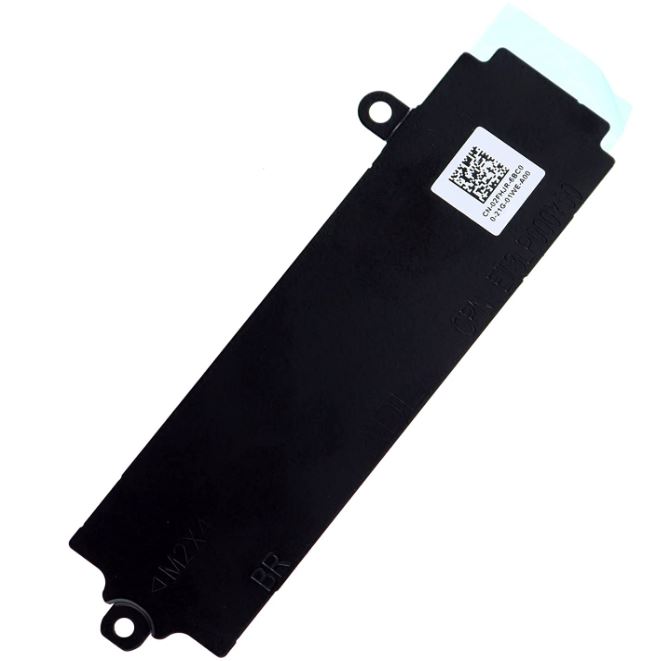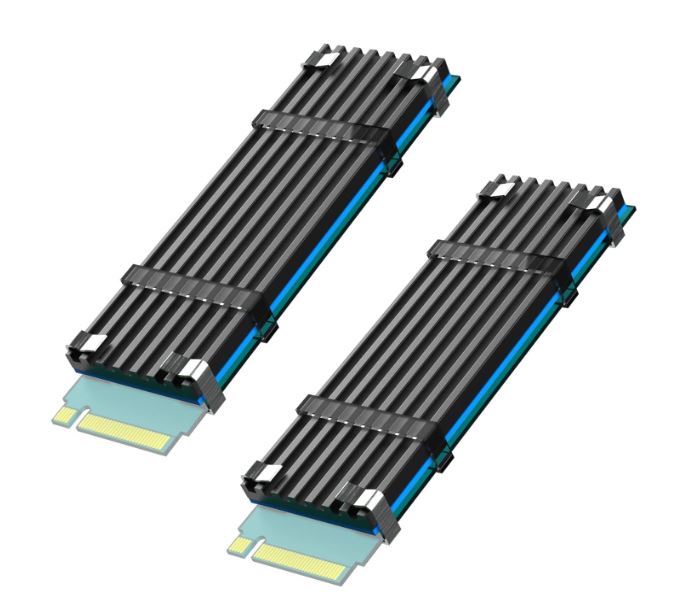SATA SSDs are a significant improvement over conventional hard drives for the majority of users. The switch from a hard disk to an SSD is astounding after using one for a few years.
This is particularly true if you get a trustworthy SSD with a respectable DRAM cache. The transition from a solid SSD to a lightning-fast NVMe one, though, doesn’t feel all that different for the ordinary consumer, at least.
However, there’s a good probability that you’re not the typical consumer if you’re reading this advice.
You can be a video editor or someone who transfers enormous files continuously. Whatever the circumstances, you stand to gain from NVMe speeds. Especially given that random read/write rates for PCIe Gen 4 SSDs are breaking all previous records.
What is M.2 SSD Heatsink?
In contrast to SSDs without heat sinks, the heatsink is a part of the motherboard that distributes heat from the drive when an intensive operation is occurring.
This enables the SSD to function for a longer time and has sustained read and write performance.
However, it appears that there is a small issue here. While having a fast NVMe SSD is excellent, they may get rather warm.
This is expected given that the scenario probably contains numerous components.
Heat has the potential to reduce the drive’s lifespan and eventually destroy performance.
As a result, it becomes sensitive to purchase a heatsink for your drive.
M.2 NVMe drives use the PCIe (Peripheral Component Interconnect Express) interface to communicate with the system, which allows for faster data transfer rates and lower latency compared to other interfaces like SATA.
However, this also means that the drive can generate more heat, which can cause it to throttle performance or even fail if the temperature gets too high.
By adding a heatsink to an M.2 NVMe drive, you can help dissipate some of the heat generated by the drive, which can help prevent throttling and extend the lifespan of the drive.
Heatsinks work by increasing the surface area of the drive, which allows for more effective heat transfer to the surrounding air or other cooling solutions like fans or liquid cooling systems.
Best NVMe Heatsinks for Laptop
Here are the top choices from our side:
1. Laptop NVMe M.2 Heatsinks by SGTKJSJS
This M.2 NVMe heatsink is appropriate for M.2 2280 SSDs. It comes with a very little price and also you will get two thermal pads for free.
It is compatible with all laptops and desktop PCs, and it fits Samsung models 950 PRO, 850 EVO, 960 EVO, and 970 EVO well.
In order to prevent overheating and throttling, the M.2 SSD must be cooled to a safe temperature with a 10-20°C cooling effect, which requires a minimum installation height of 1.5mm.
High-performance Thermal Heatsink made of 100% copper that has been chopped and polished.
Moreover, unique silicone 2 pieces of 0.5mm/1mm thick heat padding that can be used on uneven surfaces.
For a small footprint in laptops, there are two mounting options: a rubber ring and a high temperature-insulating sticker.
Anyone should be able to install these heatsinks quite easily because they were simple to install.
My only thinking is that perhaps you could make the drive non-conductive if it is contacting something.
However, I didn’t require them, and my laptop is still functional.
Although it’s great that they provided two different pad thicknesses, I choose to utilize the thicker ones as my laptop had some space.
Keeping your expensive drives cool is well worth the money and works for optimum performance and longevity.
2. Glotrends Universal M.2 SSD Heatsink
So you blew the entire budget on a lightning-fast NVMe SSD. Yet you are concerned about it slowly deteriorating because it’s running a little hot.
The Glotrends Universal M.2 Heatsink is a good choice, nevertheless, if you are looking for a low-cost cooling solution.
All M.2 2280 SSD and M.2 heatsink models, including the WD Black SN850, Sabrent Rocket 4 Plus, Sabrent Rocket 4, Samsung 980 Pro, 970 Pro, Silicon Power US70, and others, are universally compatible with these models.
To maintain the performance of the M.2 PCIe SSD, the thermal pad transfers heat from the M.2 SSD to the M.2 heatsink.
Working temperatures range from 40 °C to 200 °C and the material is electrically insulating, anti-static, fire retardant, buffering, non-toxic, and odourless.
In addition, resistant to corrosion and stimulation without causing harm to electronic devices.
Ageing takes 1-3 years, however, frequent use will hasten aging. Little bit flexible, a small bit soft, but with no elasticity, pull too hard and it will shatter.
This indicates that it can readily function with a range of disks, including the more expensive Samsung SSDs.
The heatsink’s fins are made of aluminium, while its thermal pads are made of silicone.
Other than that, the design is unobtrusive, so it should blend in with your rig without standing out.
Five pieces each measuring 2.64 by 0.79 by 0.04 and 2.64 by 0.79 by 0.02 inches are included in the package, which can be easily stacked to accommodate various needs.
3. M.2 2280 SSD Heatsink Copper Thermal Shield
Use this Heatsink Thermal Plate to add a 2280 SSD with Slot 2/Slot 1 to the Dell G15 5520 Gaming Laptop series.
You are moreover ensuring the most effective performance of your computer while minimizing costly downtime and maintenance.
Only 2280 solid-state drives are supported by this heat shield, which is only compatible with the Dell G15 5520, 5521, and 5525 Gaming Laptop series.
The item’s dimensions are 3.54 x 0.91 x 0.2 inches and it weighs 0.02 kilos.
Every pack includes 1x M.2 2280 SSD Heatsink Thermal Shield with a screw.
4. GLOTRENDS M.2 Heatsink with M.2 Thermal Pad
Budget constraints do not preclude you from purchasing a heatsink and sacrificing the quality of your PC build.
I am not even kidding, guys. Now you can buy a heatsink without shelling out a lot of money.
One of the best inexpensive SSD heatsinks is the Glotrends Universal M.2 SSD Heatsink.
A M.2 heatsink cooler is suitable for installation on a PS5 or PC. A 0.12-inch (3-mm) high m.2 heatsink that is suitable for PC and PS5 installation.
All M.2 2280 SSD models, including those from WD Black SN850, Sabrent Rocket 4 Plus, Sabrent Rocket 4, Samsung 980 Pro, Samsung 970 Pro, Silicon Power US70, and others, are universally compatible.
Metal clips and rubber bands are a novel dual installation solution for M.2 SSD installation.
There is no need to be concerned about SSD long-term high-temperature operation or rubber band material aging.
Depending on the environment, a cooling effect of 5°C–20°C is used to maintain your M.2 SSD’s performance, even when it is operating at full capacity.
A heatsink can increase the lifespan of an M.2 PCIe SSD. There is also a thermal pad. The thermal pad is placed between the M.2 SSD and M.2 Heatsink in order to conduct heat from the M.2 SSD to the M.2 Heatsink.
It has a low viscosity, is insulating, and has low thermal conductivity.
The item’s dimensions are 2.76 x 0.87 x 0.12 inches (22 x 70 x 3 millimeters), its net weight is 0.28 ounces (or 8 grams), and it has a cooling effect of 5 to 20 degrees Celsius.
You need to remove the thermal pad’s clear protective layer; if you don’t, there won’t be any thermal conductivity.
Ageing takes 1-3 years, although regular use will speed up the process. If you pull on something that is only somewhat elastic and slightly soft, it will break.
5. M.2 Heatsink Cooler Heat Sink
The very first recommendation we would love to introduce to readers is the SGTKJSJS double heatsink.
The model itself was launched officially in 2021, which is quite recent, guaranteeing it almost every latest technology for a heatsink.
Fully compatible with Samsung models PS5, 860 EVO, 960 EVO, 970 EVO, and 970 Pro.
This M.2 SSD heatsink is compatible with all single-sided types. It is constructed of an aluminium alloy with silver plating that helps to reduce static electricity and a surface anodic oxidation process.
The dimensions are 3 x 0.95 x 0.4 in. in size. Two heatsinks that are suitable for PC M.2 Slot and PS5 installation.
This heatsink is also specially designed for PC and PS5 users, allowing its ultimate performance on the two devices.
Thermal conductivity in the heatsink is remarkable, and it is probably one of the best thermal conductors available on the market.
Heat performance can reach from 10 to 20 Celsius degrees, specifically. Installation was simple, however, because the strips were a little bit longer than I needed, I had to trim a tiny portion off each of the two pieces that were included.
To improve the performance of the heat pads, be sure to remove the sticker from the hard drive.
Helps to somewhat reduce heat and probably extends the hard drive’s lifespan.
Considerations Before Buying the Best SSD Heatsink
When buying the finest SSD heatsink, there are a few factors to keep in mind.
1. Material
Copper and aluminium are two materials that are frequently used in heatsink construction.
You can pick one of them. Aluminum is the best material to choose if you want to protect your SSD from intense heat.
Copper heatsinks are less expensive and take up less room.
Copper heatsinks, however, are less effective than aluminium ones at shielding an SSD from high temperatures.
2. Size
The size of the heatsink is crucial first. Make sure the heatsink you select fits your device because certain heatsinks are made to only suit specific types of SSDs.
If you wish to place a heatsink on an SSD on your laptop. In that scenario, make sure the laptop isn’t too large so that the heatsink can cover the SSD.
The heatsink should next be verified to ensure that it is compatible with the SSD you are using.
3. Cooling Power
Second, the heatsink’s ability to conduct cooling is crucial. Check how much heat the heatsink can dissipate and whether it has the capacity to dissipate that much heat because you don’t want a heatsink that can’t handle the heat produced by the SSD.
The majority of contemporary heatsinks include thermal materials that enable them to withstand a lot of heat.
Take the heatsink out of its case and set it down on a thermal pad or another heat-dissipating piece of metal to quickly assess how much heat your heatsink can withstand.
Now for a few seconds, give the heatsink a few watts of power. If the heatsink can effectively remove the heat produced by the SSD, it should maintain a reasonable level of cooling while doing so.
4. System Prerequisites
The type of system you are utilizing should then be taken into account.
Consider a heatsink that is more compact than one made for a larger system if your system is smaller and has lower noise requirements.
A bigger heatsink might also be more effective at cooling a bigger SSD.
The noise that the heatsink will generate should be taken into account when selecting one for your SSD.
You might want to seek for a heatsink that is more compact than one made for a larger system if you want to keep your system quiet.
5. Price
Finally, the cost is also crucial. While you don’t want to spend a fortune on a heatsink, you also don’t want to get one that will only be used seldom.
There are many inexpensive heatsinks available, and some of them are actually quite good. Which type of heatsink you choose is entirely up to you.
Conclusion
You should never operate an NVMe SSD in your computer without adequate cooling.
Heatsinks, whether active or passive, significantly lower the temperature of your NVMe SSD, especially when it is under a lot of strain.
For most users, active M.2 coolers with fans may be overkill, but if you have a small PC case or one with poor ventilation, you may want to consider one.
We have reviewed the top 5 affordable heatsinks for your consideration; select the one that best fits your laptop model and needs.






